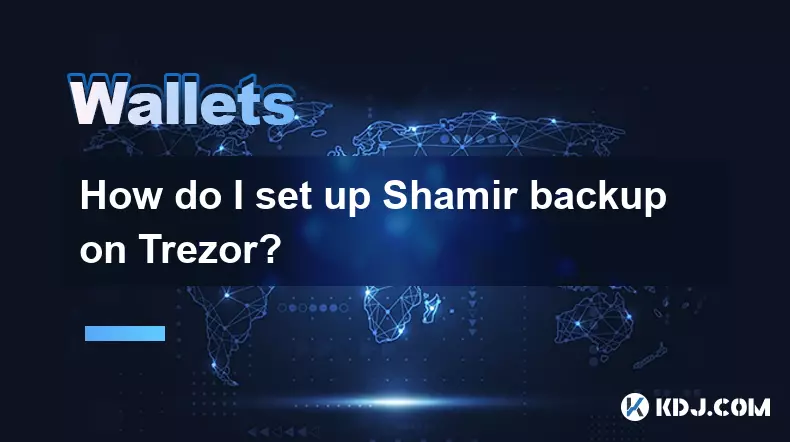-
 bitcoin
bitcoin $109667.069529 USD
-3.03% -
 ethereum
ethereum $3936.685804 USD
-4.07% -
 tether
tether $1.000493 USD
0.01% -
 xrp
xrp $2.771823 USD
-4.74% -
 bnb
bnb $957.805027 USD
-5.34% -
 solana
solana $196.735100 USD
-6.68% -
 usd-coin
usd-coin $0.999727 USD
-0.01% -
 dogecoin
dogecoin $0.227355 USD
-5.12% -
 tron
tron $0.335205 USD
-0.81% -
 cardano
cardano $0.779256 USD
-3.59% -
 ethena-usde
ethena-usde $0.999900 USD
-0.06% -
 hyperliquid
hyperliquid $42.492095 USD
-6.61% -
 chainlink
chainlink $20.501853 USD
-4.34% -
 avalanche
avalanche $28.952606 USD
-11.21% -
 stellar
stellar $0.356038 USD
-3.93%
How do I set up Shamir backup on Trezor?
Trezor's Shamir Backup splits your seed into multiple shares, requiring only a threshold to recover your wallet—enhancing security and eliminating single points of failure.
Sep 25, 2025 at 06:00 am

Understanding Shamir Backup on Trezor
Shamir Backup is an advanced feature introduced by Trezor for enhanced recovery options. Unlike traditional single seed phrase backups, Shamir Backup uses a secret sharing scheme based on Shamir’s Secret Sharing algorithm. This allows users to split their recovery seed into multiple shares, where a predefined threshold of shares is required to reconstruct the original seed.
Trezor Model T supports this feature natively, enabling users to generate 1-of-3, 2-of-3, or 3-of-5 share configurations. This means you can recover your wallet with fewer shares than the total created, offering flexibility and improved security against physical loss or theft.
- Ensure your Trezor device is updated to the latest firmware version through the Trezor Suite application.
- Reset your device through Settings > Device > Reset wallet, making sure no funds are currently stored if it's already in use.
- During the setup process, select 'Advanced recovery' instead of the standard backup option.
- Choose the number of shares and the threshold required for recovery (e.g., 2-of-3).
- Write down each generated share carefully and store them in separate secure locations.
Security Advantages of Shamir Over Standard Seed Phrases
Traditional BIP39 seed phrases offer a single point of failure. If lost or compromised, access to funds may be permanently lost or stolen. Shamir Backup mitigates these risks through decentralized storage of cryptographic fragments.
Each share generated does not reveal any information about the original seed unless the threshold number is met. This means that even if one share falls into the wrong hands, the wallet remains protected.
- Distribute shares across trusted family members or secure physical vaults without exposing full control to any single party.
- Eliminate dependency on a single piece of paper, reducing risk from fire, water damage, or misplacement.
- Customize redundancy: losing one share in a 2-of-3 scheme still allows full recovery with the remaining two.
- Avoid third-party custody solutions while maintaining high resilience.
- Protect against coercion—no individual share holder can access funds alone.
Practical Steps for Storing Shamir Shares Safely
Creating Shamir shares is only effective if they are preserved correctly. The method of storage directly impacts long-term accessibility and resistance to threats.
- Use metal backups such as Cryptosteel or Billfodl to engrave each share, protecting against environmental damage.
- Store shares in geographically separate locations—for example, home safe, safety deposit box, and a trusted relative’s house.
- Avoid digital storage; never take photos, save files, or email shares under any circumstances.
- Label shares clearly with identifiers like “Share 1 of 3” but avoid marking them as cryptocurrency-related to reduce targeting risk.
- Periodically verify readability and integrity, especially if using punch-based metal plates exposed to humidity.
Recovering Your Wallet Using Shamir Backup
When restoring access to your wallet after loss or device replacement, the recovery process requires meeting the threshold of available shares.
The Trezor device guides users step-by-step during recovery mode. It will prompt for shares until the minimum threshold is reached, at which point the original seed is reconstructed internally without ever being displayed.
- Initiate recovery mode by selecting 'Recovery' during device setup.
- Confirm the number of shares and threshold used during initial Shamir configuration.
- Enter the required number of shares using the device keypad.
- Validate each entry to prevent transcription errors.
- Once enough shares are provided, the device confirms successful recovery and becomes usable again.
Frequently Asked Questions
Can I upgrade a standard seed phrase to Shamir Backup later?Yes, but only if your current wallet is empty. You must reset the device and set up a new wallet using Shamir Backup during initialization. Migrating an existing seed to Shamir is not supported.
Is Shamir Backup compatible with other hardware wallets?Currently, Shamir Backup is exclusive to Trezor devices. While the underlying SSSS standard is open, most competing wallets do not support importing Trezor-generated shares.
What happens if I lose too many shares?If you fall below the recovery threshold (e.g., only one share available in a 2-of-3 setup), recovery becomes impossible. Always maintain at least the minimum required number of shares in secure, accessible locations.
Does Shamir Backup work with Bitcoin and other cryptocurrencies?Yes. Since the seed governs all keys derived from it, Shamir Backup protects every cryptocurrency supported by Trezor, including Bitcoin, Ethereum, Litecoin, and thousands of tokens.
Disclaimer:info@kdj.com
The information provided is not trading advice. kdj.com does not assume any responsibility for any investments made based on the information provided in this article. Cryptocurrencies are highly volatile and it is highly recommended that you invest with caution after thorough research!
If you believe that the content used on this website infringes your copyright, please contact us immediately (info@kdj.com) and we will delete it promptly.
- Bitwise, Hyperliquid ETF, and Perp DEXs: A New Era in Crypto Trading?
- 2025-09-26 12:25:15
- Ozak AI Price Prediction: Analyst Bull Case for $5 by 2026?
- 2025-09-26 12:25:15
- Bitcoin Price Wobbles: Support Failure and Trader Sentiment in the Mix
- 2025-09-26 12:45:16
- Dogecoin, Memecoins, and the Bull Cycle: Are We Still Barking Up the Right Tree?
- 2025-09-26 12:45:16
- Plasma Ignites DeFi: A New Dawn for Stablecoins and TVL?
- 2025-09-26 12:50:01
- Crypto Tax, Senate Showdown, and Trump Relief: What's the Deal?
- 2025-09-26 12:30:01
Related knowledge

How do I view smart contract interaction history in Coinbase Wallet?
Sep 24,2025 at 01:36am
Accessing Smart Contract Interaction History in Coinbase Wallet1. Open the Coinbase Wallet application on your mobile device and log in using your cre...

How do I use the token swap feature in Coinbase Wallet?
Sep 24,2025 at 05:00pm
Understanding Token Swaps in Coinbase Wallet1. The token swap feature in Coinbase Wallet enables users to exchange one cryptocurrency for another dire...

How do I participate in governance voting in Coinbase Wallet?
Sep 25,2025 at 01:55pm
Understanding Market Volatility in the Crypto Space1. Cryptocurrency markets are known for their extreme price fluctuations, often driven by sentiment...

How do I set up a custom RPC node in Coinbase Wallet?
Sep 24,2025 at 12:00pm
Understanding Custom RPC Nodes in Coinbase Wallet1. A custom RPC (Remote Procedure Call) node allows users to connect their Coinbase Wallet to a block...

How do I manage multiple assets in Coinbase Wallet?
Sep 23,2025 at 10:00am
Understanding Multi-Asset Support in Coinbase Wallet1. Coinbase Wallet allows users to store a wide variety of digital assets beyond just Bitcoin and ...

How do I connect Coinbase Wallet to a hardware wallet?
Sep 26,2025 at 02:54am
Connecting Coinbase Wallet to a Hardware Device1. Open the Coinbase Wallet app on your mobile device and ensure it is updated to the latest version. N...

How do I view smart contract interaction history in Coinbase Wallet?
Sep 24,2025 at 01:36am
Accessing Smart Contract Interaction History in Coinbase Wallet1. Open the Coinbase Wallet application on your mobile device and log in using your cre...

How do I use the token swap feature in Coinbase Wallet?
Sep 24,2025 at 05:00pm
Understanding Token Swaps in Coinbase Wallet1. The token swap feature in Coinbase Wallet enables users to exchange one cryptocurrency for another dire...

How do I participate in governance voting in Coinbase Wallet?
Sep 25,2025 at 01:55pm
Understanding Market Volatility in the Crypto Space1. Cryptocurrency markets are known for their extreme price fluctuations, often driven by sentiment...

How do I set up a custom RPC node in Coinbase Wallet?
Sep 24,2025 at 12:00pm
Understanding Custom RPC Nodes in Coinbase Wallet1. A custom RPC (Remote Procedure Call) node allows users to connect their Coinbase Wallet to a block...

How do I manage multiple assets in Coinbase Wallet?
Sep 23,2025 at 10:00am
Understanding Multi-Asset Support in Coinbase Wallet1. Coinbase Wallet allows users to store a wide variety of digital assets beyond just Bitcoin and ...

How do I connect Coinbase Wallet to a hardware wallet?
Sep 26,2025 at 02:54am
Connecting Coinbase Wallet to a Hardware Device1. Open the Coinbase Wallet app on your mobile device and ensure it is updated to the latest version. N...
See all articles










































































